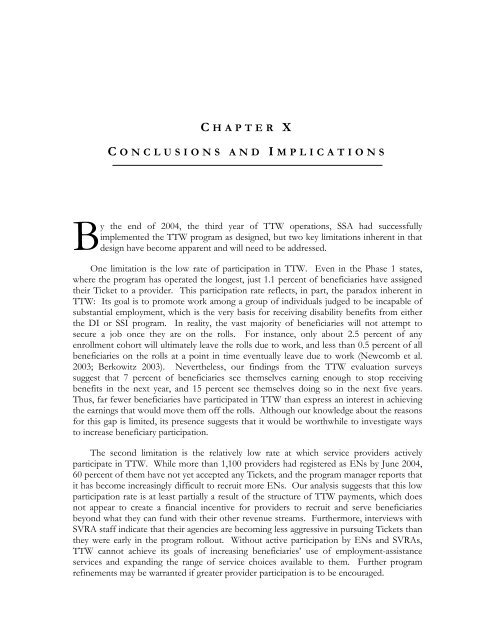Evaluation of the Ticket to Work Program, Implementation ...
Evaluation of the Ticket to Work Program, Implementation ...
Evaluation of the Ticket to Work Program, Implementation ...
You also want an ePaper? Increase the reach of your titles
YUMPU automatically turns print PDFs into web optimized ePapers that Google loves.
C HAPTER XC ONCLUSIONS AND I MPLICATIONSBy <strong>the</strong> end <strong>of</strong> 2004, <strong>the</strong> third year <strong>of</strong> TTW operations, SSA had successfullyimplemented <strong>the</strong> TTW program as designed, but two key limitations inherent in thatdesign have become apparent and will need <strong>to</strong> be addressed.One limitation is <strong>the</strong> low rate <strong>of</strong> participation in TTW. Even in <strong>the</strong> Phase 1 states,where <strong>the</strong> program has operated <strong>the</strong> longest, just 1.1 percent <strong>of</strong> beneficiaries have assigned<strong>the</strong>ir <strong>Ticket</strong> <strong>to</strong> a provider. This participation rate reflects, in part, <strong>the</strong> paradox inherent inTTW: Its goal is <strong>to</strong> promote work among a group <strong>of</strong> individuals judged <strong>to</strong> be incapable <strong>of</strong>substantial employment, which is <strong>the</strong> very basis for receiving disability benefits from ei<strong>the</strong>r<strong>the</strong> DI or SSI program. In reality, <strong>the</strong> vast majority <strong>of</strong> beneficiaries will not attempt <strong>to</strong>secure a job once <strong>the</strong>y are on <strong>the</strong> rolls. For instance, only about 2.5 percent <strong>of</strong> anyenrollment cohort will ultimately leave <strong>the</strong> rolls due <strong>to</strong> work, and less than 0.5 percent <strong>of</strong> allbeneficiaries on <strong>the</strong> rolls at a point in time eventually leave due <strong>to</strong> work (Newcomb et al.2003; Berkowitz 2003). Never<strong>the</strong>less, our findings from <strong>the</strong> TTW evaluation surveyssuggest that 7 percent <strong>of</strong> beneficiaries see <strong>the</strong>mselves earning enough <strong>to</strong> s<strong>to</strong>p receivingbenefits in <strong>the</strong> next year, and 15 percent see <strong>the</strong>mselves doing so in <strong>the</strong> next five years.Thus, far fewer beneficiaries have participated in TTW than express an interest in achieving<strong>the</strong> earnings that would move <strong>the</strong>m <strong>of</strong>f <strong>the</strong> rolls. Although our knowledge about <strong>the</strong> reasonsfor this gap is limited, its presence suggests that it would be worthwhile <strong>to</strong> investigate ways<strong>to</strong> increase beneficiary participation.The second limitation is <strong>the</strong> relatively low rate at which service providers activelyparticipate in TTW. While more than 1,100 providers had registered as ENs by June 2004,60 percent <strong>of</strong> <strong>the</strong>m have not yet accepted any <strong>Ticket</strong>s, and <strong>the</strong> program manager reports thatit has become increasingly difficult <strong>to</strong> recruit more ENs. Our analysis suggests that this lowparticipation rate is at least partially a result <strong>of</strong> <strong>the</strong> structure <strong>of</strong> TTW payments, which doesnot appear <strong>to</strong> create a financial incentive for providers <strong>to</strong> recruit and serve beneficiariesbeyond what <strong>the</strong>y can fund with <strong>the</strong>ir o<strong>the</strong>r revenue streams. Fur<strong>the</strong>rmore, interviews withSVRA staff indicate that <strong>the</strong>ir agencies are becoming less aggressive in pursuing <strong>Ticket</strong>s than<strong>the</strong>y were early in <strong>the</strong> program rollout. Without active participation by ENs and SVRAs,TTW cannot achieve its goals <strong>of</strong> increasing beneficiaries’ use <strong>of</strong> employment-assistanceservices and expanding <strong>the</strong> range <strong>of</strong> service choices available <strong>to</strong> <strong>the</strong>m. Fur<strong>the</strong>r programrefinements may be warranted if greater provider participation is <strong>to</strong> be encouraged.
















